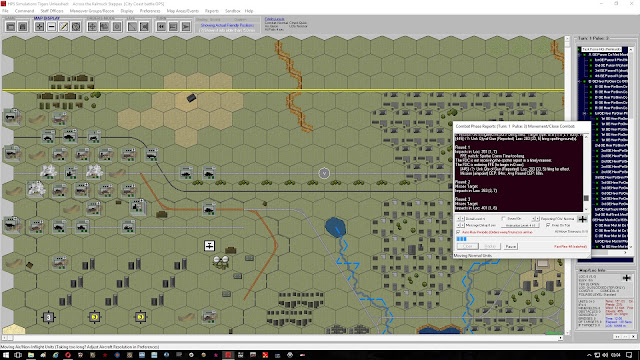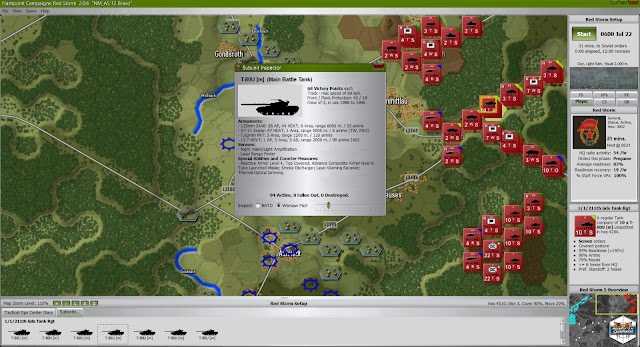The scale of the new 'Panzer Battles' series is 1 hex equals 250 meters. The master map covers 102,000 hexes covering all of the action on the southern front of the battle of Kursk. The order of battle includes over 15,800 units from this list:
Wehrmacht
SS
Luftwaffe
Red Army
Red Guards
Just like 'Panzer Battles Normandy', Kursk comes with unit component, order of battle, and scenario editors. To let you tinker to your hearts content. The maps can be "chopped" into smaller segments for making custom scenarios.
There are 60 scenarios to choose from. They range from 5 to 38 turns in length.
- July 4th; XXXXVIII Panzer Korp's preliminary attacks – 2 scenarios
- July 5th; II SS Panzer Korp's – 4 scenarios
- July 5th; III Panzer Korp – 4 scenarios
- July 5th; XXXXVIII Panzer Korp – 6 scenarios
- July 6th; II SS Panzer Korp – 7 scenarios
- July 7th; III Panzer Korp – 6 scenarios
- July 7th; XXXXVIII Panzer Korp – 1 scenarios
- July 8th; Voronezh Front – 9 scenarios
- July 9th; XXXXVIII Panzer Korp – 7 scenarios
- July 10th; II SS Panzer Korp – 6 scenarios
- July 11th; II SS Panzer Korp – 4 scenarios
- July 12th; Voronezh & Steppe Fronts – 4 scenarios
Almost half of the scenarios are 15 turns or less, and are meant to be playable in roughly one hour. There are some scenarios that are especially made for head-to-head gaming, but we solo players have not been forgotten. Other scenarios are meant for playing against the AI. The modes of play available are:
Against the AI
Play by email (PBEM)
Lan and internet live
Two player hotseat
The game comes with copious amounts of documentation. Here are a few examples:
- Designer Notes (PDF file)
- Planning Maps (PDF file)
- Getting Started (PDF file)
- User Manual (PDF file)
- Summer Map (JPG file)
- Summer Map with Units (JPG file)
- Visual Order of Battle Guide (PDF File)
The laundry list of updates and improvements just keep getting longer. As of now, 'Panzer Battles Kursk' is at version 1.02. There is no reason to assume that Wargame Design Studio won't continue with the practice of John Tiller Software, and keep releasing updates, etc. John Tiller games are still updating some of their games from fifteen years ago. I know for a fact that play testing is a long and nit picking process, and that no matter how many scenarios one of their games comes with, all of the scenarios are tested before the game ends up on your computer.
The game play, like all Tiller based games, is meant to provide the player with the most realistic battle situations, and command options available. This does make their games more mentally labor intensive than most. Like most cerebral games, the more you put into it the more you will get out of it. The scenarios with their smaller size, compared to 'Panzer Campaigns', are meant to be nail biters, and they succeed in this admirably. You cannot afford to leisurely play 'Panzer Battles', and decide to just go through the motions for this turn. The AI or your opponent will pounce on your mistakes and teach you a lesson very quickly. Playing as the Russian, you will need all of your powers and the strength of your units to stop the German juggernaut. A little good luck is also helpful. Playing as the Germans, you cannot afford to make any mistakes if you are to see the onion spires of Kursk.
The 'Panzer Battles' games fill a void in the wargaming world. The scenarios included in both the games are either small enough to get in a game before dinner, or large enough to keep you occupied for much longer. Rarely do you find so many scenarios in a game now, and probably never of such diversity. These games, especially with their modding options, should be a big hit with the wargaming crowd. That would be excellent, because then they could afford to branch out into less known and more arcane battles of the period. Some battles have never had games about them, or very rarely. I see on the Wargame Design Studio website there is already a 'Panzer Battles 3' listed. There is also a write up about the creation of a Maleme scenario.
I am going to button my hatch now and get back to the maelstrom that was the battle of Kursk. Happy holidays to all and I hope you have a great new year ahead of you. Please also look at my 'Panzer Battles Normandy' review.
http://www.awargamersneedfulthings.co.uk/2016/07/john-tillers-panzer-battles-of-normandy.html
Robert
Game: Panzer Battle's Kursk Southern Flank
Developer: Wargame Design Studio
Distributor: John Tiller Software
Date of Review: 12/5/16
These features include improved user interface, new terrain graphics and simplified folder structures. The full list of changes is below;
Kursk Patch 1.02 Changelog
Bug Fixes
- Adjusted reporting for air attacks
- Corrected hex stack reporting when a wreck is in the hex
- Corrected a crash bug when the last man/gun/vehicle is destroyed by defensive fire
- Corrected a fog of war bug when right clicking
- Included a check that all off board artillery is not placed on the map.
- Any fixed unit that is fired on will now instantly un-fix
- Units could use a bridge while in travel mode to enter an obstacle and then exit the hex, rather than lose their whole movement allowance. This has been corrected and units will now lose all their movement points if they move into an obstacle hex
- Engineer units were in some cases isolated when in a minefield - this should no longer occur
- Engineer units will not clear a minefield in a turn that they recover from disruption
- Adjacent engineers no longer remove isolation for units in minefields
- Off map artillery was not firing during the defensive fire phase - this will now occur at the same frequency as on map artillery
- Engineers that attempt to damage a bridge or AT ditch will reveal themselves if currently concealed
- Units can no longer combine if in mismatched travel modes
- File mismatch due to different encryption setting during PBEM - fixed
- Campaign auto-advance on wrong password entry – fixed
Enhancements
- Newly implemented: View > Map Elevations, View > Map Coordinates, View > Map Combat Modifiers.
- Optional Zoom to hotspot – Settings > Center Zoom on Hot Spot
- New parameter file entry - Fatigue factor. Used for scaling fatigue accumulation. Set at 2.0 for Normandy & Kursk. Will be 3.0 for future titles to match the fatigue calculations in Panzer Campaigns. 3.0 is the more appropriate value to use, but none of the Kursk & Normandy scenarios were tested with the higher value
- New on counter broken and disrupted markings - visible when stacked and unstacked.
- New Getting Started documentation, including Campaign Primer and Terrain & Combat tables
- Updated General Help guide with a revised layout and additional information.
- Updated User guide with a revised layout and additional information. All manuals are a work in progress and will continue to be rationalised over time.
Order of Battle
- Corrected Soviet 27 76mm Gun btty (hs) causing scenario crash
Graphics Changes
- New -small- terrain features. All files are under \Maps\ Terrain Small. Copy all the 8 files into the map directory and overwrite the existing. To revert to the graphics released in Patch 1.01, copy the files out of \Maps\ Terrain - Default directory back into the Map directory. To revert to the graphics released in the original game, copy the files out of \Maps\ Terrain - Original directory back into the Map directory
- New Cover art. Various versions available in the \Screen directory
Map Changes
- Alternate small map graphics included
User Interface Changes
- New Shortcut keys
- New Toolbar Icons in traditional and standard configuration. Small, Medium and Large versions also available for each.
- File/folder reorganization, with creation of the following new folders: Data (.oob & .pdt files), Logs (.log files), Manuals (.pdf files), Saves (.bt? files), Scenarios (.scn, .map files etc.), Screens (various game .bmp files).
- New logging system (with various .log files in the new Logs folder), to assist in game testing, and identifying and fixing bugs.














































Follow Us